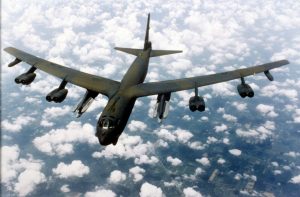Late last week, a U.S. B-52 Stratofortress flew within 2 nautical miles of Cuarteron Reef, one of the controversial Spratly Island features where China has constructed artificial islands. The bomber was on a routine mission over the South China Sea, according to the Wall Street Journal, but the flyby near Cuarteron was unintentional. The incident comes more than a month after the United States staged its first freedom of navigation operation (FONOP) in the South China Sea by sailing the USS Lassen, an Arleigh Burke-class destroyer, within 12 nautical miles of Subi Reef. Last week’s flyby bears similarity to an incident in November involved B-52s in the South China Sea. The Pentagon is reportedly investigating why a B-52 flew so close to Cuarteron Reef—one of the early explanations from the Pentagon is that bad weather contributed to the off-course flight.
China’s reaction to the miscalculated U.S. flyby has been unsurprising. Beijing, in a statement released on Saturday, described the incident as a serious military provocation. “The actions by the U.S. side constitute a serious military provocation and are rendering more complex and even militarising conditions in the South China Sea,” the Chinese defense ministry noted. According to Xinhua, China’s state news agency, Chinese military personnel posted on the island “went on high alert and warned the aircraft to leave.” This behavior suggests that Beijing reacted to the B-52 flyby as they have to recent U.S. military movements near Chinese artificial islands in the Spratlys, including a May flyby of a P-8A Poseidon surveillance aircraft and the Lassen‘s FONOP near Subi Reef in October. In addition to the public statement on the incident, Beijing filed a diplomatic complaint with the U.S. embassy in Beijing.
Mark Wright, a spokesperson for the Pentagon, clarified that the B-52 flyby near Cuarteron was not intended as a FONOP. Specifically, he noted that there was “no intention of flying within 12 nautical miles of any feature.” This incident, by virtue of being an unplanned encounter, could complicate how the U.S. thinks about freedom of navigation in the South China Sea. Particularly, the Pentagon’s reaction and eagerness to clarify the unplanned nature of the flyby to China could undermine U.S. claims that China’s maritime claims in the South China Sea are excessive.
It is particularly unfortunate that the flyby took place near Cuarteron Reef, which, unlike Subi Reef and Mischief Reef, may be entitled to a territorial sea based on its pre-reclamation status as a rock. As I’ve described in detail before, Subi Reef and Mischief Reef are apt targets for planned U.S. FONOPs because they were low-tide elevations before China began reclamation and construction work there. Thus, per the United Nations Convention on the Law of Sea, they may not be entitled to territorial seas, regardless of which claimant state in the region administers them (Taiwan, Vietnam and the Philippines also claim these features).
In a sense, to remain in line with its policy of not taking any position on the sovereignty of South China Sea features, the U.S. government had to clarify that the B-52 flyby was unintentional and was not an intention to invalidate maritime claims within 12 nautical miles of Cuarteron. The incident also highlights the necessity of freedom of navigation and overflight assertions in the South China Sea. As James Kraska wrote before the U.S. began conducting FONOPs near China’s artificial islands in the Spratlys, if China’s maximum theoretical claims generated by these artificial islands gained even de facto recognition, “the oceans and airspace will come to look like Swiss cheese and be practically closed off to free navigation and overflight.”
This is why it may be an inadvertent benefit that the U.S. unintentionally tested China’s resolve about the rights generated by Cuarteron Reef (and, thus, other rocks that are now artificial islands in the Spratlys, including Fiery Cross and Johnson reefs). The first FONOP resolved some ambiguity about how China would respond both rhetorically and militarily within 12 nautical miles of its artificial islands in the Spratlys. Last week’s B-52 flyby also reduced some ambiguity about how Beijing would react to so-called “serious military provocations” within 12 nautical miles of other features.

































